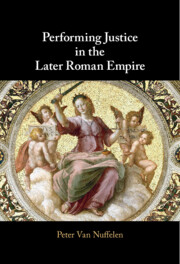
- Publisher:
- Cambridge University Press
- Online publication date:
- August 2025
- Print publication year:
- 2025
- Online ISBN:
- 9781009603706
- Subjects:
- Ancient History, Classical Studies

In the Later Roman Empire (AD 300–650), power seems to manifest itself mostly through legislation, bureaucracy, and an increasingly distant emperor. This book focuses instead on personal interaction as crucial to the exercise of power. It studies four social practices (petitions, parrhesia, intercession, and collective action) to show how they are much more dynamic than often assumed. These practices were guided by strong expectations of justice, which constrained the actions of superiors. They therefore allowed the socially inferior to develop strategies of conduct that could force the hand of the superior and, in extreme cases, lead to overturning hierarchical relations. Building on the analysis of these specific forms of interaction, the book argues for an understanding of late antique power rooted in the character and virtue of those invested with it.
 Loading metrics...
Loading metrics...
* Views captured on Cambridge Core between #date#. This data will be updated every 24 hours.
Usage data cannot currently be displayed.
The PDF of this book complies with version 2.1 of the Web Content Accessibility Guidelines (WCAG), covering newer accessibility requirements and improved user experiences and achieves the intermediate (AA) level of WCAG compliance, covering a wider range of accessibility requirements.
Allows you to navigate directly to chapters, sections, or non‐text items through a linked table of contents, reducing the need for extensive scrolling.
Provides an interactive index, letting you go straight to where a term or subject appears in the text without manual searching.
You will encounter all content (including footnotes, captions, etc.) in a clear, sequential flow, making it easier to follow with assistive tools like screen readers.
You get concise descriptions (for images, charts, or media clips), ensuring you do not miss crucial information when visual or audio elements are not accessible.
You will still understand key ideas or prompts without relying solely on colour, which is especially helpful if you have colour vision deficiencies.
You gain clarity from ARIA (Accessible Rich Internet Applications) roles and attributes, as they help assistive technologies interpret how each part of the content functions.